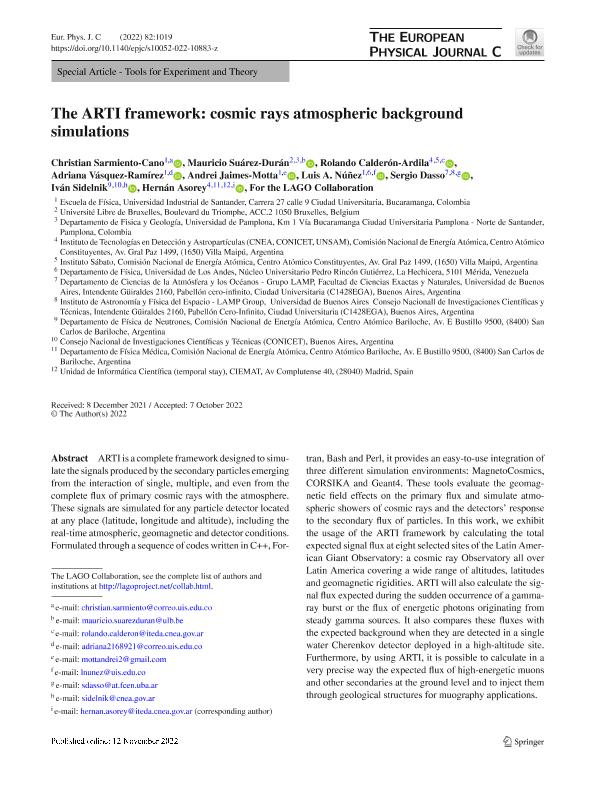Mostrar el registro sencillo del ítem
dc.contributor.author
Sarmiento Cano, Christian Andres

dc.contributor.author
Suárez Durán, Mauricio

dc.contributor.author
Calderón Ardila, Rolando

dc.contributor.author
Vásquez Ramirez, Adriana Carolina

dc.contributor.author
Jaimes Motta, Andrei
dc.contributor.author
Núñez, Luis A.
dc.contributor.author
Dasso, Sergio Ricardo

dc.contributor.author
Sidelnik, Iván Pedro

dc.contributor.author
Asorey, Hernán Gonzalo

dc.date.available
2023-08-02T13:30:47Z
dc.date.issued
2022-11
dc.identifier.citation
Sarmiento Cano, Christian Andres; Suárez Durán, Mauricio; Calderón Ardila, Rolando; Vásquez Ramirez, Adriana Carolina; Jaimes Motta, Andrei; et al.; The ARTI framework: cosmic rays atmospheric background simulations; Springer; European Physical Journal C: Particles and Fields; 82; 11; 11-2022; 1-17
dc.identifier.issn
1434-6044
dc.identifier.uri
http://hdl.handle.net/11336/206493
dc.description.abstract
ARTI is a complete framework designed to simulate the signals produced by the secondary particles emerging from the interaction of single, multiple, and even from the complete flux of primary cosmic rays with the atmosphere. These signals are simulated for any particle detector located at any place (latitude, longitude and altitude), including the real-time atmospheric, geomagnetic and detector conditions. Formulated through a sequence of codes written in C++, Fortran, Bash and Perl, it provides an easy-to-use integration of three different simulation environments: MagnetoCosmics, CORSIKA and Geant4. These tools evaluate the geomagnetic field effects on the primary flux and simulate atmospheric showers of cosmic rays and the detectors’ response to the secondary flux of particles. In this work, we exhibit the usage of the ARTI framework by calculating the total expected signal flux at eight selected sites of the Latin American Giant Observatory: a cosmic ray Observatory all over Latin America covering a wide range of altitudes, latitudes and geomagnetic rigidities. ARTI will also calculate the signal flux expected during the sudden occurrence of a gamma-ray burst or the flux of energetic photons originating from steady gamma sources. It also compares these fluxes with the expected background when they are detected in a single water Cherenkov detector deployed in a high-altitude site. Furthermore, by using ARTI, it is possible to calculate in a very precise way the expected flux of high-energetic muons and other secondaries at the ground level and to inject them through geological structures for muography applications.
dc.format
application/pdf
dc.language.iso
eng
dc.publisher
Springer

dc.rights
info:eu-repo/semantics/openAccess
dc.rights.uri
https://creativecommons.org/licenses/by/2.5/ar/
dc.subject
Cosmic Rays
dc.subject
Atmosphere
dc.subject
Space Weather
dc.subject.classification
Física de Partículas y Campos

dc.subject.classification
Ciencias Físicas

dc.subject.classification
CIENCIAS NATURALES Y EXACTAS

dc.title
The ARTI framework: cosmic rays atmospheric background simulations
dc.type
info:eu-repo/semantics/article
dc.type
info:ar-repo/semantics/artículo
dc.type
info:eu-repo/semantics/publishedVersion
dc.date.updated
2023-08-02T10:48:31Z
dc.journal.volume
82
dc.journal.number
11
dc.journal.pagination
1-17
dc.journal.pais
Alemania

dc.description.fil
Fil: Sarmiento Cano, Christian Andres. Consejo Nacional de Investigaciones Científicas y Técnicas; Argentina. Universidad Industrial Santander; Colombia
dc.description.fil
Fil: Suárez Durán, Mauricio. Université Libre de Bruxelles; Bélgica
dc.description.fil
Fil: Calderón Ardila, Rolando. Comisión Nacional de Energía Atómica. Centro Atómico Constituyentes; Argentina. Consejo Nacional de Investigaciones Científicas y Técnicas; Argentina
dc.description.fil
Fil: Vásquez Ramirez, Adriana Carolina. Universidad Industrial Santander; Colombia
dc.description.fil
Fil: Jaimes Motta, Andrei. Universidad Industrial Santander; Colombia
dc.description.fil
Fil: Núñez, Luis A.. Universidad Industrial Santander; Colombia
dc.description.fil
Fil: Dasso, Sergio Ricardo. Universidad de Buenos Aires; Argentina
dc.description.fil
Fil: Sidelnik, Iván Pedro. Comisión Nacional de Energía Atómica. Centro Atómico Bariloche; Argentina. Consejo Nacional de Investigaciones Científicas y Técnicas; Argentina
dc.description.fil
Fil: Asorey, Hernán Gonzalo. Consejo Nacional de Investigaciones Científicas y Técnicas; Argentina. Comisión Nacional de Energía Atómica. Centro Atómico Bariloche; Argentina
dc.journal.title
European Physical Journal C: Particles and Fields

dc.relation.alternativeid
info:eu-repo/semantics/altIdentifier/doi/http://dx.doi.org/10.1140/epjc/s10052-022-10883-z
Archivos asociados
